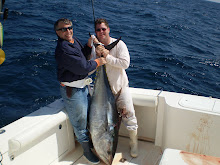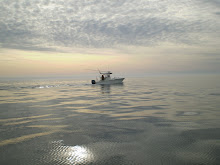
By Jim Field
We have by now caught our share of amberjacks--a.k.a. reef donkeys--on the verticle jig. I believe we have boated Lesser both Amberjacks and Greater Amberjacks--thus achieving the amberjack Grand Slam (just made this up). In this post I have amassed some information to support my hypothesis. The key, I believe, is found in looking closely at the dorsal fins. The Greater Amberjack clearly has a verticle fin with a straight edge on the traling side. The Lesser Amberjack, I am thinking, has a "notched" trailing edge on the dorsal fin. Hopefully you agree with this call, Jon.
Amberjack Type 1: Lesser Amberjack, Seriola fasciata

- Biological description: The lesser amberjack occurs in the Eastern and Western Atlantic Oceans. In the Atlantic, it is found from Massachusetts to Brazil. This is a benthopelagic species, primarily found in depths of 55-130 m (180-427 ft). Maximum reported size is 68 cm (27 in) FL. It feeds on squids and fishes.
Amberjack Type 2: Greater Amberjack, Seriola dumerili

- Physical description: The coloration of the greater amberjack is characterized by a dark stripe on the head which extends from the origin of the first dorsal gin through the eye. The back is blue or olivaceous, and the sides and belly are silvery-white. Occationally there is an amber or pinkish cast to the body. Juveniles have have five or six dark verticle bars along the sides.
- Biological description: Greater amberjack are found in the Mediterranean Sea and the Atlantic, Pacific, and Indian Oceans. In the western Atlantic, they are distributed from Nova Scotia to Brazil, including the Gulf of Mexico and the Caribbean, where they concentrate around reefs, rock outcrops and wrecks. Greater amberjack that are at least 5 years of age, or 33.5 inches long, spawn from March through July. They may reach a size of 6 feet, and weigh nearly 200 pounds. Voracious predators, greater amberjacks eat mostly crab, squid and other fishes found on reefs. They are often found in small groups and are friendly to divers.
Jon with an amberjack caught a few years ago. I believe this is a smaller Greater Amberjack. Note the dorsal fin and silver coloration

An amberjack caught by Jon on May 17, 2010. Note how different the dorsal fin is, with the notch on the reverse side. I believe this is either a Lesser Amberjack, or, something else entirely

Jon holding the Lesser Amberjack, which appears in this picture angle to be even smaller then when splayed out on the coffin cooler

An unknown fisherman with a smaller Greater Amberjack--note the dorsal fin and silver coloration

An unknown fisherman with a large Greater Amberjack










No comments:
Post a Comment